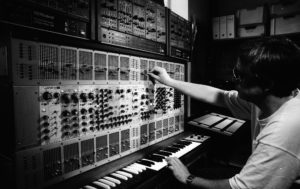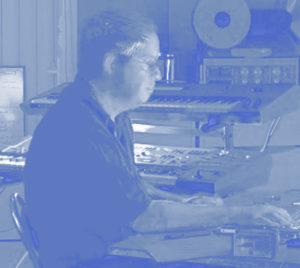Christian Wittman Music
A Journey Through Today Ambient, Minimal, Experimental Musics. Releases, Reviews, Making of, Thoughts and Afterthoughts about Electronic Musics.
Sunday, December 21, 2025
Sunday, December 7, 2025
REVIEW OF "THE NORTHWEST PASSAGE" IN HOUZ-MOTIK MAGAZINE (ENGLISH TRANSLATION)
Review of "The Northwest Passage" by Ly Luan in HOUZ-MOTIK MAGAZINE
Sailing into the unknown: Christian Wittman and the ghosts of the Northwest Passage
By mapping the void, modern Europe convinced itself that a maritime corridor lay dormant somewhere beneath the Arctic ice. The Northwest Passage was born of a geographical assumption that became a political obsession. Behind the legend were figures embarking on a journey that did not yet exist, and often toward their own demise. a chronicle of a record that scrutinizes the margins of the world rather than its myth.
Christian Wittman explores the myth of the Northwest Passage without heroism or folklore. In The Northwest Passage, he sculpts a soundscape of drones, creaks, and mists, where the Arctic becomes less a setting than a space of uncertainty. This is not an expedition narrative, but rather an inner drift, attentive to silences and discreet phenomena. The ambient album questions what remains when bodies disappear, transforming ice into something to be listened to rather than a spectacular image...
A tribute stripped of heroism
What strikes us immediately is the restraint. Wittman does not dramatize anything; he stretches out the space, lets the air circulate, and creates an unstable horizon where landmarks dissolve. The historical explorers, those who, from Hudson to Franklin, attempted to open a route between the Atlantic and the Pacific, never appear explicitly. The album simply inhabits their absence. We perceive fragments, auditory silhouettes, movements of dark masses; never heroic gestures, nothing commemorative. The tribute is conveyed through the material, not through narration.
Textures: coldness as architecture. The compositions are based on meticulous layering, subterranean drones, rustling sounds worked like sediments, abrasive layers that crack and then fall silent. Here, the sea is anything but flat. It breathes, swells, recedes; it acts as a discreet engine that supports each sequence. The creaking of icebergs seems to emerge from an intermediate space—neither documentary nor fictional—and it is this ambiguity that gives the record its density. The result clearly evokes a work of synthesis and sound design that seeks to reproduce physical phenomena rather than illustrate a polar postcard.
“It is not the Arctic that is inhospitable, but our ignorance of how to live in it.” – Vilhjalmur Stefansson (The Friendly Arctic (1921)
Inner journey vs. icy odyssey
The real movement of the album lies in its breathing. The pieces open like corridors of mist, tighten, fragment, then let the diffuse light back in. This is not a chronological narrative. We drift along, as if each track were questioning a state, a wait, a disorientation, an asceticism, without ever seeking resolution. The cold acts here as a functional metaphor: it strips away, reduces gestures, slows down thought. We find ourselves listening to the silences more than the sounds, as if the material were deliberately disappearing to allow vertigo to emerge.
The Arctic, not as a setting but as an interval. The last third of the album is the most compelling: Wittman achieves a sobriety reminiscent of certain minimalist works where a single movement is enough to maintain tension. The Arctic is not treated as a sublime spectacle, but as a zone of indeterminacy. It brings to mind the lines of old maps, the hesitant tracings, the errors of judgment that made the world seem bigger than it was. Far from the routes that were once sought to be forced through the ice floes, this album reminds us that there are still passages that can only be opened by paying attention. Here, the crossing is not geographical: it takes place in the fragile interval between what resonates and what fades away.
Fantastic review of "The Northwest Passage' in the webzine Houz-Motic by Ly Luan
Naviguer dans le blanc : Christian Wittman et les fantômes du Passage du Nord-Ouest
À force de cartographier le vide, l’Europe moderne s’est persuadée qu’un corridor maritime dormait quelque part sous les glaces arctiques. Le Passage du Nord-Ouest est né d’un postulat géographique devenu obsession politique. Derrière la légende, des silhouettes embarquées vers une route qui n’existait pas encore, et souvent vers leur propre disparition ; chronique d’un disque qui scrute les marges du monde plutôt que son mythe
Christian Wittman explore le mythe du Passage du Nord-Ouest sans héroïsme ni folklore. Dans The Northwest Passage, il sculpte un paysage sonore fait de drones, de craquements et de brumes, où l’Arctique devient moins un décor qu’un espace d’incertitude. Pas de récit d’expédition, plutôt une dérive intérieure, attentive aux silences et aux phénomènes discrets. Le disque ambient interroge ce qui subsiste quand les corps disparaissent, et transforme la glace en matière d’écoute plutôt qu’en image spectaculaire…
Un hommage débarrassé d’héroïsme

Ce qui frappe d’emblée, c’est la retenue. Wittman ne dramatise rien, il étire l’espace, laisse l’air circuler, installe un horizon instable où les repères se dissolvent. Les explorateurs historiques, ceux qui, de Hudson à Franklin, ont tenté d’ouvrir une route entre Atlantique et Pacifique, n’apparaissent jamais explicitement. Le disque se contente d’habiter leur absence. On perçoit des fragments, des silhouettes auditives, des mouvements de masse sombre ; jamais de gestes héroïques, rien de commémoratif. L’hommage passe par la matière, pas par la narration.
Textures : le froid comme architecture. Les compositions reposent sur un travail de couches minutieuses, drones souterrains, bruissements travaillés comme des sédiments, nappes abrasives qui se fissurent puis se taisent. Ici, la mer n’a rien d’aplatissant. Elle respire, gonfle, recule ; elle agit comme un moteur discret qui soutient chaque séquence. Les craquements d’icebergs semblent surgir d’un espace intermédiaire – ni documentaire, ni fictionnel – et c’est cette ambiguïté qui donne au disque sa densité. Le rendu évoque nettement un travail de synthèse et de design sonore cherchant à reproduire des phénomènes physiques plutôt qu’à illustrer une carte postale polaire.
« It is not the Arctic that is inhospitable, but our ignorance of how to live in it.” – Vilhjalmur Stefansson (The Friendly Arctic (1921)
Traversée intérieure vs odyssée glacée

Le véritable mouvement du disque se trouve dans sa respiration. Les pièces s’ouvrent comme des couloirs de brume, se resserrent, se fragmentent, puis laissent de nouveau entrer la lumière diffuse. On n’est pas dans un récit chronologique. On avance par dérive, comme si chaque piste interrogeait un état, attente, désorientation, ascèse, sans jamais chercher la résolution. Le froid agit ici comme une métaphore fonctionnelle : il dépouille, réduit les gestes, ralentit la pensée. On se surprend à écouter les silences plus que les sons, comme si la matière disparaissait volontairement pour laisser émerger le vertige.
• À lire aussi sur Houz-Motik : une exploration sonore signée Andrew Heath et Christian Wittman
L’Arctique, non comme décor mais comme intervalle. Le dernier tiers du disque est le plus convaincant : Wittman y atteint une sobriété qui rappelle certains travaux minimalistes où un seul mouvement suffit pour maintenir la tension. L’Arctique n’y est pas traité comme un spectacle sublime, mais comme une zone d’indétermination. On pense aux lignes de cartes anciennes, aux tracés hésitants, aux erreurs d’appréciation qui faisaient le monde plus grand qu’il n’était. Loin des routes qu’on cherchait jadis à forcer dans la banquise, ce disque rappelle qu’il existe encore des passages qui ne s’ouvrent qu’en prêtant attention. Ici, la traversée n’est pas géographique : elle se joue dans l’intervalle fragile entre ce qui résonne et ce qui s’efface.
Saturday, December 6, 2025
Thursday, December 4, 2025
The Northwest Passage
Dear all,
I invite you to join me in a trip into the uncharted, with my new album, "The Northwest Passage, an ambient odyssey through the silent, frozen expanse of the northern seas.
The Northwest Passage was imagined and postulated from the globes and planispheres of modern Europe, before being sought by adventurous navigators who explored the icy waters of the Arctic in search of a sea route linking Europe to Asia, the Atlantic to the Pacific, an alternative to long voyages via the Strait of Magellan or the Cape of Good Hope.
In this album, slow, drifting drones, misty pads, and spectral textures conjure glacial horizons, icy winds, and the faint pulse of unseen currents.
Each note carries you deeper into a world of solitude and shadow, where the beauty of the polar night unfolds in haunting, cinematic detail. This is sound as exploration—an immersive voyage to the edge of the world, and beyond.
Thanks for your support and your interest in my music!
Christian
Wednesday, December 3, 2025
Sunday, November 30, 2025
INSPIRATION (ABOUT A PHOTO OF BRIAN ENO)
This beautiful photo of Brian Eno is surely a carefully staged scene...
But it touches me with the allegory of creation (artistic, musical, intellectual) that it presents.
Colors, light and shadows, temperature, the time of day or night all play a role in inspiration.
Brian Eno sits alone, in a serene and meditative position, lost in thought, or simply thinking of nothing and letting ideas randomly emerge.
His body posture is relaxed, while his face, seen in profile, is focused, with an inward gaze.
The double-aspect window opens onto a wooded park, and the light seems to caress and paint the foliage. We can guess at the subtle variations in color and brightness as the leaves are stirred by the wind or passing clouds filter the sun's rays.
It looks like a video of Brian Eno himself... "Wednesday morning" or "Friday afternoon", perhaps?
A video static, but undulating in subtle variations over the hours.
Three balls are arranged on the floor: the smallest, white, in the middle of the other two, darker.
Were they arranged this way on purpose? Or are they the result of chance?
This triad opens up a space for creation, made up of rebounds and possible cycles. It could be a planetary system yet to be discovered. Unless it symbolizes the listener between two stereo sound sources.
These three balls are like a Zen koan. What do they mean? Creation becomes possible when we realize that they mean nothing. They are there and invite us to write the first words, to make the first brushstroke, to play the first notes.
What remains is the dark fireplace, which contrasts with the brightness of the window.
Brian Eno turns his back on it.
To create is to turn towards the light.
Even if darkness and the call of nothingness also have their beauty...
This photo of Brian Eno, composed like a painting or a still video, accompanies me in my own work of musical composition.








